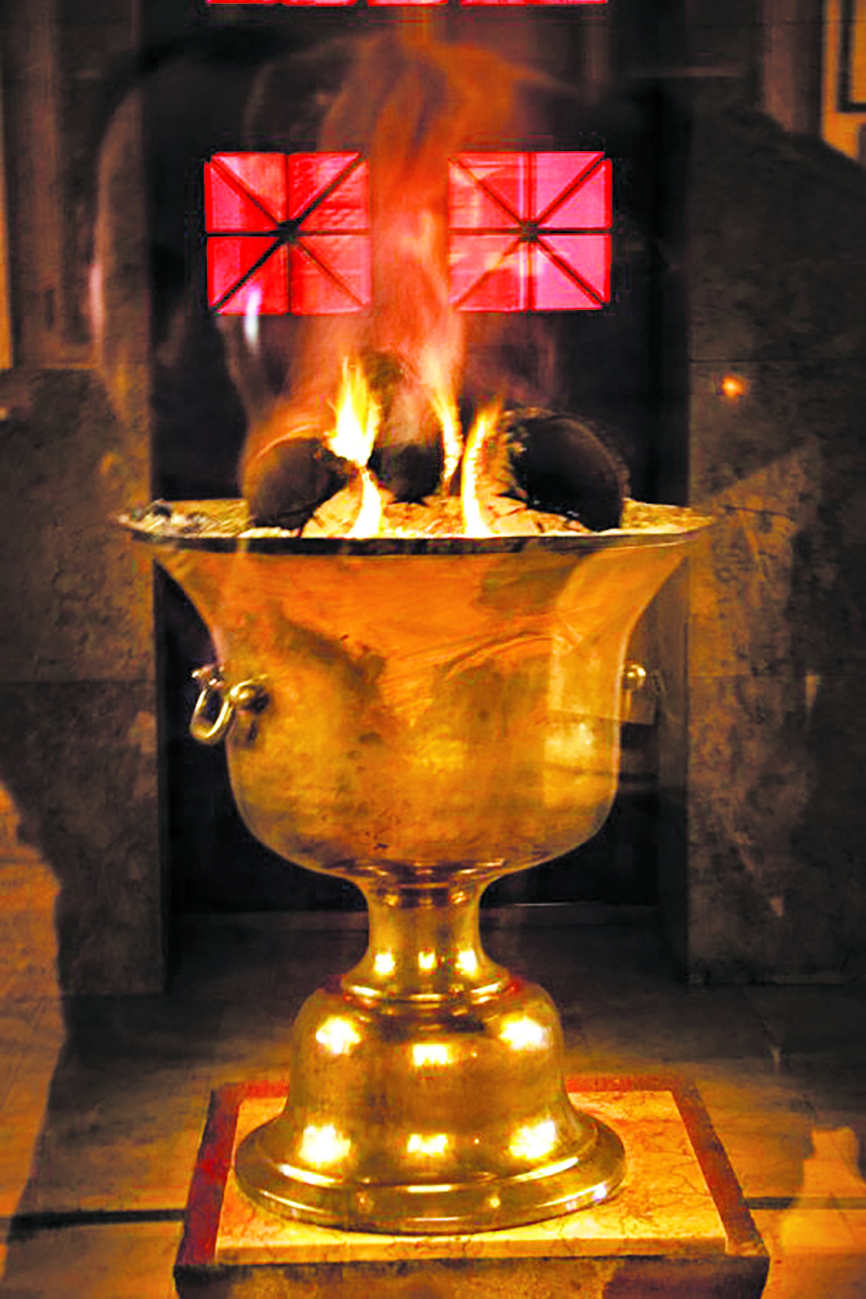The consecration (Prana pratishtha) ceremony, conducted on 22nd January, 2024, of the Ram Lalla (infant form of Lord Ram) Murti (idol) in Ayodhya, received tremendous attention worldwide. This ceremony reminded many of us of how our sacred Agyari and Atash Bahram fire, and the building housing the sacred fire, are also consecrated – first physically and then ritually, thus making the fire temple complex a vortex of Divine Energy!
 To ‘consecrate’ is defined as ‘make or declare sacred’. Let’s look at similarities between the Vedic tradition of infusing life into a stone deity and the Zoroastrian tradition of bringing consciousness to the energy of fire, through prayers and rituals.
To ‘consecrate’ is defined as ‘make or declare sacred’. Let’s look at similarities between the Vedic tradition of infusing life into a stone deity and the Zoroastrian tradition of bringing consciousness to the energy of fire, through prayers and rituals.
Animating The Ordinary To Extra-Ordinary
Prāṇa pratiṣṭhā is a ritual to literally bring life or Prana to the idol. The Upanishad (the Hindu equivalent of the Gatha) state: “Sarvam khalu dam Brahma” or everything existing in the universe has God-consciousness. Consecration of an idol involves prana-pratistha or ‘investiture with life’ and ‘Chakshudana’ or “opening the third eye” (of the idol). The items of worship, namely, the holy water of the holy rivers, the flowers, the grass and the various leaves are all addressed in intimate terms, on par with the worshipper himself apropos their respective levels of consciousness.
In like manner, the fires burning in our Agyari and Atash Bahram are no ordinary fires – these are consecrated fires (Ijaila Atash) which, doctrinally, are regarded as conscious living entities, worthy of our reverence and worship. This, of course, is without prejudice to the fact that Ahura Mazda is the ultimate Spirit/Divinity we worship through the consecrated fires.
Significance Of Rituals
Most religions comprise the doctrine and the practices of the Faith. Rituals are not ‘meaningless’ – these are a process of falling in step with life, as they unfold within the frames of time and space. Rituals such as the boi ceremony or offering a Nyaish before a consecrated fire emphasize our relationship with both – the material and spiritual worlds. When performed with understanding and feeling, rituals can educate and uplift the spirit. They help us to experience and recognize the harmony that exists between the material and spiritual worlds.
Worship Of Divinity
Like Hindus, Zoroastrians also believe in consciousness as fundamental. We regard matter as derivative from consciousness. There is nothing pagan in a Zoroastrian praying before the sun, the moon, the waters, the mountains or fire or for that matter, a Hindu praying before a consecrated stone idol. All creation is Divine and Divinity is revered through its creations.
Says Prof. Max Muller in ‘Introduction to the Science of Religion’ (pg.93) “Their (Aryans’) worship is not, as has been so often said, a worship of Nature. But, I should venture to call it a worship of God in nature”. Max Muller’s worship of God in nature really means, for all practical purposes, the worship of Life in nature. In the words of Byron, “My altars are the mountains and the ocean, earth, air, stars, all that springs for the Great Whole, who hath produced and will receive the soul.” In offering worship at an Agyari or Atash Bahram, one is, in essence, offering worship to Ahura Mazda through Fire.
Consecrating The Idol
Murti pratishtha or consecrating the idol is a ritual invoking Divinity to enter into the murti by performing Vedic rites and chanting mantras, as prescribed by the Shastras (scriptures). Once consecrated, the murti becomes a living form of Divinity. Consecration involves several rituals starting with Karmakutir wherein the sculptor removes all impurities from the idol with Darbha grass. Several ahuti (offerings) are made to the fire while chanting sacred sanskrit manta. This is followed by Jaladhivas or submerging the murti in holy water and later in Dhanyadhivas covering the murti in rice to further purify the murti. Ghrutadhivas stage involves abhishek or the ritual of bathing the murti with milk and panchamrut, water containing the essence of various fragrant flowers and leaves and water which has been poured over the horns of a cow, and sugar cane juice. Netra-anavaran rite involves opening the eyes of the deity with a gold shalaka (needle).
Nyasvidhi is the first step in the prana pratishtha. Nyas means, touching. Nyasvidhi invokes various deities, such as Brahma, Indra, Surya, and others, in different parts of the murti. Chanting mantra, and with the wave of the darbha grass and shalaka (golden needle), the rite begins from the head of the murti down to its feet. First the prana (life breath) enters the murti, followed by the jiva (soul). Lastly, the indriyas (senses) are infused into the murti.
Consecrating The Holy Fire
To consecrate the highest grade of fire or Atash Bahram – the Fire of Victory (over evil), sixteen different types of fires, including the fire of lightening is required. All these fires are first physically purified. Sandal wood shavings are kept on a perforated ladle and when fire from the first Afarganyu (fire vase) ignites the sandalwood in the perforated ladle, the fire is transferred to the second un-ignited Afarganyu. This process is repeated different number of times for different fires. For example, ninety times in the case of fire of lightening and ninety-one times in the case of fire sourced from a burning corpse. During this ritual, the priests continuously chant the Holy Avesta Manthra.
After all the sixteen fires are physically purified, the Yasna or Ijashne and Vendidad ceremonies are performed for each of the sixteen fires. After this, all sixteen fires are ritually amalgamated and Ijashne and Vendidad with the invocation to Sarosh Yazad is performed for three days, followed by a Yasna (Ijashne) and Vendidad each for the next thirty days, dedicated to the Ameshaspand/Yazad of the day.
The sanctum sanctorum or the Kebla, where the consecrated fire is to be enthroned, as also the building housing the sacred fire, is also consecrated, first physically by swabbing with taro and then thrice with pure well water. After this, for four days, two priests perform a Yasna and Vendidad, with the invocation of Sarosh Yazad in the fire temple building and also within the kebla and then perform a special Afringan. The Afarganyu too is consecrated by taking it into the pavi and performing the Baj of Sarosh on it.
On the day of installation, one Ijashne is performed with the invocation to Sarosh Yazad on the amalgamated consecrated fires. After this, the sacred fire is ceremoniously taken in a procession led by priests and followed by the laity and the fire is enthroned (takhta-nashin) in the sanctum sanctorum (kebla). This consecrated fire is now regarded as the Spiritual King (Atash Padshah) having consciousness and powers to bless devotees.
- The Poison of Pessimism - 27 April2024
- Celebrating The Interplay Of Life And Fire! - 20 April2024
- Customs To Observe At Atash Behram Or Agyari - 13 April2024
